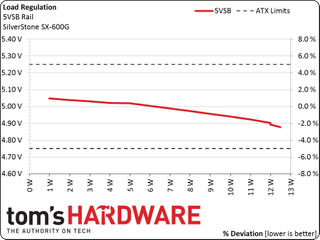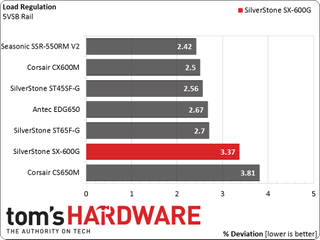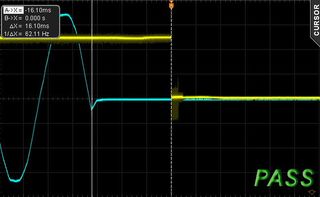SilverStone SX600-G SFX Power Supply Review
SilverStone's SX600-G is one of the most capable SFX PSUs you can buy. Six-hundred watts is a lot for this form factor, and today we are going find out if the company's offering is able to deliver its advertised power even in extreme conditions.
Why you can trust Tom's Hardware
Load Regulation, Hold-Up Time And Inrush Current
Test Setup
| Isolation Transformer | 3 KVA |
|---|---|
| AC Source | Chroma 61604 (2 KVA) |
| Power Meter | Yokogawa WT210 Power Analyzer |
| Electronic Loads | 2x Chroma 6314A Mainframes6x 63123A (350W each)1x 63122A (2x 100W)1x 63101A (200W) |
| Oscilloscopes | Rigol DS2072A, 2x Picoscope 3424, Rigol VS5042, Stingray DS1M12 |
| Multimeters | Fluke 298 & 175, Keithley 2015 THD |
| Thermocouple Data Logger | Picotech TC-08 (eight channels) |
| Sound Analyzer | Brüel & Kjær 2250-L G4Type 4189 microscope(16.6-140 dB[A]-weighted dynamic range) |
| Infrared Camera | FLIR E4 (modified to E8, 320x240 resolution) |
| Anechoic Chamber | Custom-made soundproofed with be Quiet! Noise Absorber Kit |
| Thermal Chamber | Custom-made equipped with automatically-controlled (through software) heating elements |
| Software | Custom-made application that includes monitoring, control and logging functions |
All measurements are performed using two Chroma 6314A mainframes equipped with the following electronic loads: six 63123A (350 W each), one 63102A (100 W x2) and one 63101A (200W). The aforementioned equipment is able to deliver 2500W of load, and all loads are controlled by custom-made software (Faganas ATE). We also use a Rigol DS2072A oscilloscope, a Picoscope 3424 oscilloscope, a Picotech TC-08 thermocouple data logger, two Fluke multimeters (289 and 175), a Keithley 2015 THD 6.5-digit bench DMM and a Yokogawa WT210 power meter. In addition, we include a wooden box, which, along with some heating elements, we used as a hot box. Moreover, we have at our disposal three more oscilloscopes (Rigol VS5042, Stingray DS1M12 and a second Picoscope 3424) and a Class 1 Brüel & Kjær 2250-L G4 Sound Analyzer, which is equipped with a type 4189 microphone that features a 16.6-140 dB(A)-weighted dynamic range. Finally, the latest addition in our testing gear is a FLIR E4 infrared camera, which, through some firmware modifications (many thanks to the fine folks at EEVblog's forums for this) is now able to deliver 320x240 resolution.
We conduct all of our tests at 40 °C to 45 °C ambient temperature to more accurately simulate the environment seen inside a typical system, with the range being derived from a standard ambient assumption of 23 °C, and 17 to 22 °C added for the typical temperature rise within a system.
Primary Rails Load Regulation
The following charts show the voltage values of the main rails, recorded over a range from 40 W to the maximum specified load, and the deviation (in percent) for the same load range.






5VSB Regulation
The following chart shows how the 5VSB rail deals with the load we throw at it.


Hold-Up Time
Hold-up time is an important PSU characteristic; it represents the amount of time, usually measured in milliseconds, that a PSU can maintain output regulations as defined by the ATX spec without input power. In other words, it is the amount of time the system can continue to run without shutting down or rebooting during a power interruption. The ATX specification sets the minimum hold-up time to 16ms with the maximum continuous output load.
In the following screenshot, the blue line is the mains signal and the yellow line is the "Power Good" signal. The latter is de-asserted to a low state when any of the +12V, 5V or 3.3V output voltages fall below the under-voltage threshold, or after the mains power has been removed for a sufficiently long time to guarantee that the PSU cannot operate anymore.


The registered hold-up time meets the ATX spec's requirements, although we suspected that the small bulk capacitor would pose a problem here.
Inrush Current
Inrush current or switch-on surge refers to the maximum, instantaneous input current drawn by an electrical device when it is first turned on. Because of the APFC capacitor's charging current, PSUs produce large inrush current right as they are turned on. This can trip circuit breakers and fuses, and may also damage switches, relays and bridge rectifiers. As a result, the lower the inrush current of a PSU right as it is turned on, the better.


The registered inrush current is pretty low with 115 V and significantly higher at 230 V, though still on the low side.
Load Regulation And Efficiency Measurements
The first set of tests reveals the stability of the voltage rails and the PSU's efficiency. The applied load equals (approximately) 10 percent to 105 percent of the maximum load the supply can handle, in increments of 10 percentage points.
We conducted two additional tests. In the first metric, we stressed the two minor rails (5V and 3.3V) with a high load while the load at +12V was only 0.10 A. This test reveals whether the PSU is Haswell-ready or not. In the second test, we determined the maximum load the +12V rail could handle while the load on the minor rails was minimal.
| Test | 12V(A/V) | 5V(A/V) | 3.3V(A/V) | 5VSB(A/V) | DC/AC (W) | Efficiency(%) | Fan Speed(RPM) | NoisedB(A) | In/Out(°C) | PF/AC(V) |
|---|---|---|---|---|---|---|---|---|---|---|
| 1 | 3.151 | 1.993 | 1.970 | 0.995 | 59.75 | 81.44 | 1660 | 34.8 | 37.46 | 0.955 |
| 12.112 | 5.015 | 3.349 | 5.020 | 73.37 | 42.04 | 115.1 | ||||
| 2 | 7.350 | 2.988 | 2.964 | 1.195 | 119.71 | 88.15 | 1725 | 35.8 | 38.08 | 0.982 |
| 13.093 | 5.005 | 3.338 | 5.004 | 135.80 | 42.79 | 115.0 | ||||
| 3 | 11.912 | 3.506 | 3.480 | 1.400 | 179.87 | 89.37 | 1930 | 38.8 | 40.15 | 0.983 |
| 12.071 | 4.994 | 3.330 | 4.989 | 201.27 | 45.01 | 115.0 | ||||
| 4 | 16.482 | 4.013 | 3.975 | 1.605 | 239.75 | 89.93 | 2175 | 39.2 | 40.75 | 0.989 |
| 12.048 | 4.984 | 3.318 | 4.973 | 266.61 | 46.33 | 115.0 | ||||
| 5 | 20.725 | 5.024 | 4.986 | 1.815 | 299.68 | 89.92 | 2400 | 42.3 | 41.37 | 0.992 |
| 12.025 | 4.970 | 3.308 | 4.956 | 333.27 | 48.00 | 114.9 | ||||
| 6 | 24.988 | 6.046 | 6.005 | 2.020 | 359.68 | 89.66 | 2635 | 45.4 | 42.24 | 0.993 |
| 12.003 | 4.959 | 3.296 | 4.940 | 401.14 | 49.63 | 114.8 | ||||
| 7 | 29.264 | 7.069 | 7.029 | 2.231 | 419.59 | 89.20 | 2845 | 49.6 | 43.31 | 0.994 |
| 11.979 | 4.946 | 3.285 | 4.923 | 470.38 | 51.49 | 114.8 | ||||
| 8 | 33.567 | 8.107 | 8.063 | 2.445 | 479.67 | 88.65 | 3230 | 50.2 | 44.31 | 0.995 |
| 11.955 | 4.933 | 3.274 | 4.903 | 541.11 | 53.41 | 114.7 | ||||
| 9 | 38.317 | 8.633 | 8.607 | 2.450 | 539.69 | 88.07 | 3390 | 52.2 | 44.48 | 0.995 |
| 11.930 | 4.922 | 3.264 | 4.892 | 612.78 | 54.53 | 114.7 | ||||
| 10 | 43.046 | 9.164 | 91.28 | 2.560 | 599.60 | 87.42 | 3535 | 53.2 | 45.01 | 0.995 |
| 11.904 | 4.910 | 3.253 | 4.878 | 68.87 | 55.7 | 114.7 | ||||
| 11 | 46.623 | 9.169 | 9.146 | 2.561 | 629.58 | 87.26 | 3535 | 53.2 | 45.25 | 0.995 |
| 11.889 | 4.906 | 3.248 | 4.874 | 721.48 | 56.24 | 114.6 | ||||
| CL1 | 0.099 | 11.012 | 11.005 | 0.004 | 92.77 | 83.96 | 2930 | 50.0 | 42.24 | 0.976 |
| 12.117 | 4.988 | 3.328 | 5.014 | 110.49 | 50.37 | 115.2 | ||||
| CL2 | 45.954 | 1.002 | 1.003 | 1.002 | 607.43 | 88.00 | 3330 | 51.6 | 44.63 | 0.995 |
| 11.899 | 4.931 | 3.277 | 4.936 | 690.27 | 55.04 | 114.7 |
Before we start commenting on the results, we should remind you that this is an SFX-based unit, so it cannot be compared directly to standard ATX PSUs. Roomy dimensions allow for bigger components that are more suitable for higher loads. We see the +12V rail stay within two percent, a satisfactory result, while the minor rails perform decently. We would have liked the 3.3V rail to demonstrate lower than three-percent deviation, though.
With regard to efficiency, the small SilverStone supply clears the 80 PLUS Gold requirements, even though we tested at a higher ambient temperature than the 80 PLUS organization. Our most significant criticism is the excess noise that the small fan generates as it tries to keep up with heat output. We did push the SX600-G to its limits, and the outcome was definitely loud. Normally, we overload PSUs under test at 110 percent of their maximum-rated capacity. However, in this case, we noticed a prominent high-pitched noise coming out of the PSU, so we decided to perform the overload test with 105 percent load instead. It's hard to be overly picky with an SFX unit that already delivers 600W of power.
Current page: Load Regulation, Hold-Up Time And Inrush Current
Prev Page A Look Inside And Component Analysis Next Page Efficiency, Temperatures And NoiseStay on the Cutting Edge
Join the experts who read Tom's Hardware for the inside track on enthusiast PC tech news — and have for over 25 years. We'll send breaking news and in-depth reviews of CPUs, GPUs, AI, maker hardware and more straight to your inbox.
Aris Mpitziopoulos is a Contributing Editor at Tom's Hardware US, covering PSUs.
-
Onus The price is a little high.Reply
I'm not sure I agree with such high ratings of some of the Corsair units, with as many failures as they apparently experience within the first year. It also doesn't bode well for the poor capacitors in this Silverstone either. So far though, at this level, there is no other choice. -
damric The review was perfect this time, Aris. My only nitpick is the graphs are hard to read.Reply
Well done.
As far as the PSU itself, I was turned off by the 40C max operating temp fan kicks up at 45... bah... If they would have used better caps then temp could easily been rated for 50C. -
David Dewis I wanna use this to run a GTX 980 in the Silverstone RVZ02 with a i5-4670 (non K) That is all.Reply -
g-unit1111 Nice to see that manufacturers are starting to take small form factor builds seriously. I especially like the direction that Silverstone is going in. First the RVZ02B now high quality SFF power supplies. Wave of the future?Reply -
DarkSable This is a wonderful power supply, if you aren't pushing it altogether too hard.Reply
@David Dewis, go look at the Sandia Cooler. When you're done lusting after that, look at the Id-cooling Is-vc45 Vapor Chamber CPU Cooler... which you can buy right now and use to overclock an i5 in the new Raven just fine. I've got my media PC in an RVZ01 with a Pentium anniversary edition overclocked to heck, and it does just fine. (I can't wait for the RVZ02 to put my gaming rig in and run watercooling out the back.) -
DarkSable That being said. Tom's. What are you doing.Reply
Silverstone just released the SX500-LG, which is a very slightly longer (130mm) SFX-profile power supply that fits a 120mm fan on top, instead of a dinky, noisy 80mm fan. That's the power supply that I want to see a review of! -
g-unit1111 Reply15283400 said:(I can't wait for the RVZ02 to put my gaming rig in and run watercooling out the back.)
I very badly want a RVZ02, it will make a nice home for my old i5-3570K. :lol: -
Grognak 52dB and more than 25 idle... "Tiny box that makes a lot of noise" isn't my definition of SFF.Reply -
Aris_Mp I will ask for the SX-500LG, however I have many samples to process till its turn comes to hit the test bench. Unfortunately a full PSU review needs lots of time and I won't do rushed reviews.Reply